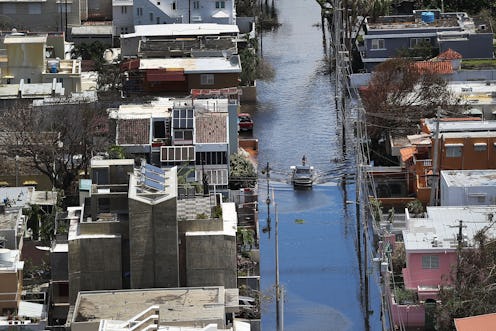News
Here's How Desperate Things Are In Puerto Rico Right Now

Last week, Hurricane Maria tore through the U.S. territory of Puerto Rico, in what was the most devastating natural disaster to hit the island in a long, long time. The effect on its infrastructure and the prospects for recovery echo what transpired in the greater Houston area after Hurricane Harvey, except it's seemingly not getting the same level of coverage and attention, either from the mainstream media or the federal government. In short, if you're curious about what's going on in Puerto Rico, you're probably showing a little more curiosity and interest than the president of the United States himself.
After days of people calling on Trump to respond to the crisis ― Puerto Ricans are U.S. citizens, after all, despite the fact that a staggering number of Americans reportedly don't know that fact ― he finally did, on Twitter, and the results were not very good. Specifically, in a series of three tweets, he described Puerto Rico as "in deep trouble," before noting that the island owed billions of dollars to Wall Street and banks which "sadly, must be dealt with." In a tweet the next day, he thanked the mayor of San Juan and promised more food and water was on the way.
As for what's actually transpiring on the ground in Puerto Rico, numerous reports have painted an incredibly dire picture, reporting in so many ways that it may not be fully recovered from the devastating storm for years.
For example, on Monday night, the governor of Puerto Rico told MSNBC host Chris Hayes that a staggering 60 percent of the island has no access to potable water, which has the makings of a true humanitarian nightmare in the making. Electricity has also been knocked out on a grand scale, with nearly the entire country left without power.
According to the Associated Press, electricity has thankfully been restored to some hospitals on the island, but the actual process of restoring power to the broader citizenry, according to Public Affairs Secretary Ramon Rosario, could take months. The process will likely be exacerbated by the fact that the debt crisis has reportedly left the island's state-run power company broke.
All told, according to MarketWatch, an analysis of the extent of the damage in Puerto Rico determined that it could cost an estimated $30 billion for the U.S. territory to recover from the furious storm. Hurricane Maria was a Category 5 hurricane when it hit Puerto Rico, the strongest classification on the Saffir-Simpson scale.
The threat of destabilizing calamity hasn't entirely passed yet, either. Some 70,000 Puerto Ricans have reportedly been evacuated from areas near the Guajataca Dam, due to the threat of it failing and letting loose a life-threatening flood of water. Thus far, a reported 16 people have died amid the destruction of Hurricane Maria. If the dam were to fail, and people hadn't evacuated the area, that number could have increased dramatically.
To hear Puerto Rico's Resident Commissioner Jenniffer Gonzalez tell it, the damage wrought by Hurricane Maria has likely set the island back decades, and relief is badly needed:
The devastation in Puerto Rico has set us back nearly 20 to 30 years. I can't deny that the Puerto Rico of now is different from that of a week ago. The destruction of properties, of flattened structures, of families without homes, of debris everywhere. The island's greenery is gone.
The nautical ports in the Puerto Rican capital of San Juan have reopened during the daytime now, but only to receive aid shipments, slow though they've reportedly been to arrive. Drinkable water, food, and generators are topping the list of the most essential goods right now ― if you want to find out how to effectively donate your money or resources to the recovery, there are several options you can consider.